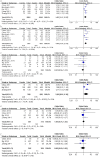The impact of atosiban on pregnancy outcomes in women undergoing in vitro fertilization-embryo transfer: A meta-analysis
- PMID: 28422984
- PMCID: PMC5396917
- DOI: 10.1371/journal.pone.0175501
The impact of atosiban on pregnancy outcomes in women undergoing in vitro fertilization-embryo transfer: A meta-analysis
Abstract
Background: Atosiban is administered to women undergoing in vitro fertilization-embryo transfer (IVF-ET) to improve pregnancy outcomes. However, the results of this treatment were controversial. We conducted this meta-analysis to investigate whether atosiban improves pregnancy outcomes in the women undergoing in vitro fertilization (IVF).
Methods: Databases of PubMed, EMBASE, Web of Science, China BioMedicine, and Google Scholar were systematically searched. Meta-analyses were performed to investigate whether atosiban improves pregnancy outcomes in the women undergoing IVF.
Results: Our results showed that atosiban was associated with higher implantation (OR = 1.63, 95% CI: 1.17-2.27; P = 0.004) and clinical pregnancy (OR = 1.84, 95% CI: 1.31-2.57; P < 0.001) rates. However, atosiban showed no significant association with the miscarriage, live birth, multiple pregnancy or ectopic pregnancy rates. When a further subgroup analysis was performed in the women undergoing repeated implantation failure (RIF), implantation (OR = 1.93, 95% CI: 1.45-2.57; P < 0.001), clinical pregnancy (OR = 2.48, 95% CI: 1.70-3.64; P <0.001) and the live birth (OR = 2.89, 95% CI: 1.78-4.67; P < 0.001) rates were significantly higher in the case group. Nevertheless, no significant difference was detected in the miscarriage and multiple pregnancy rates between the case and control groups.
Conclusion: Atosiban may be more appropriate for women undergoing RIF and play only a limited role in improving pregnancy outcomes in the general population of women undergoing IVF. These conclusions should be verified in large and well-designed studies.
Conflict of interest statement
Figures





References
Publication types
MeSH terms
Substances
LinkOut - more resources
Full Text Sources
Other Literature Sources

